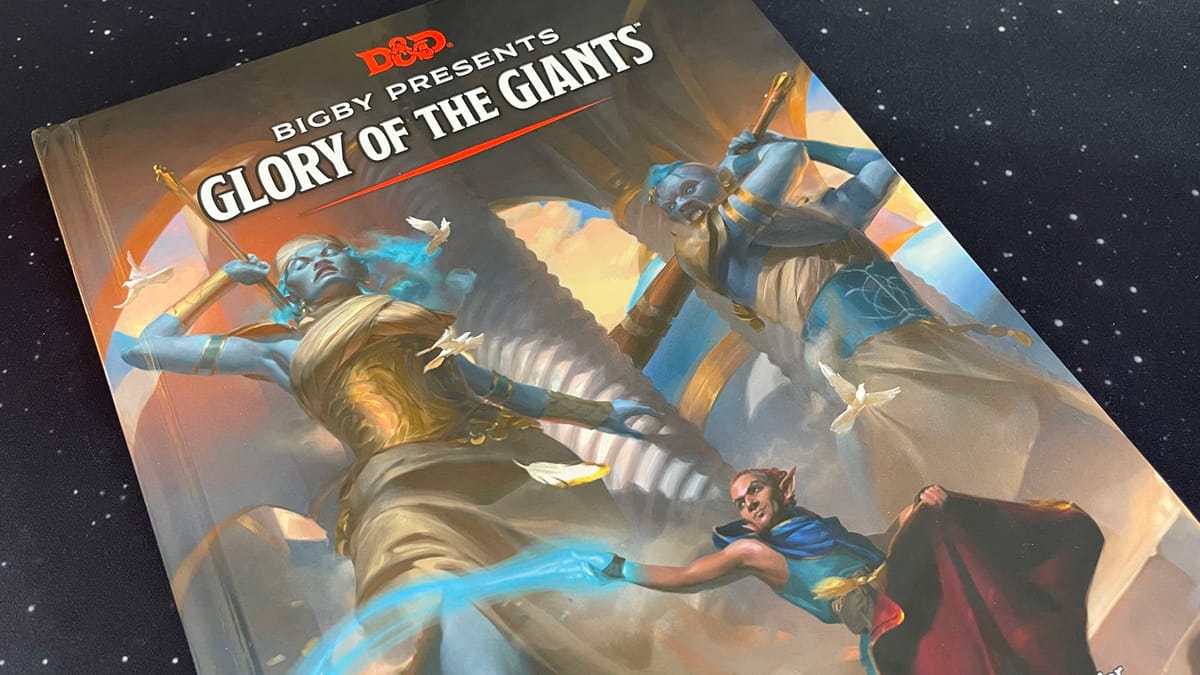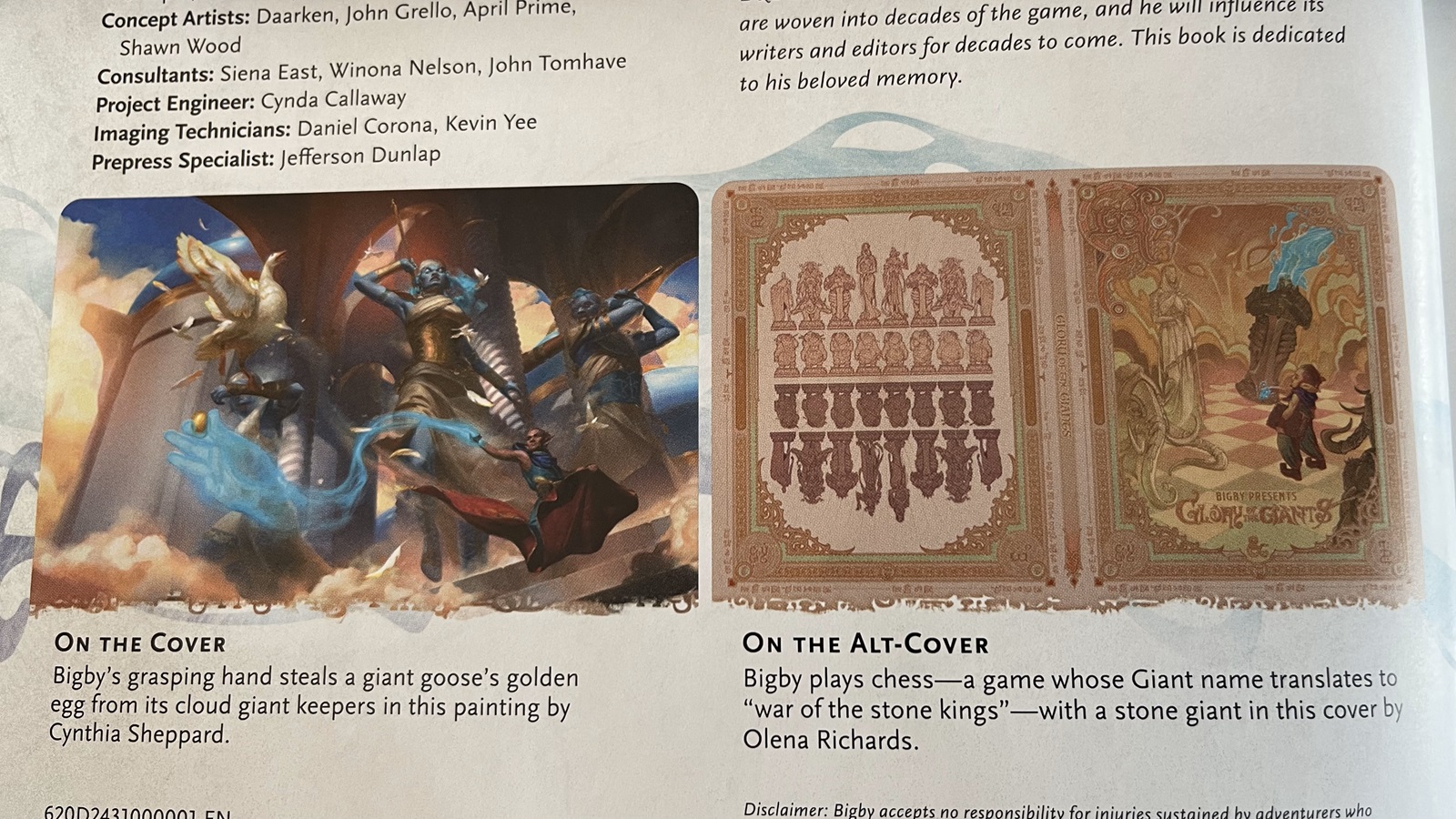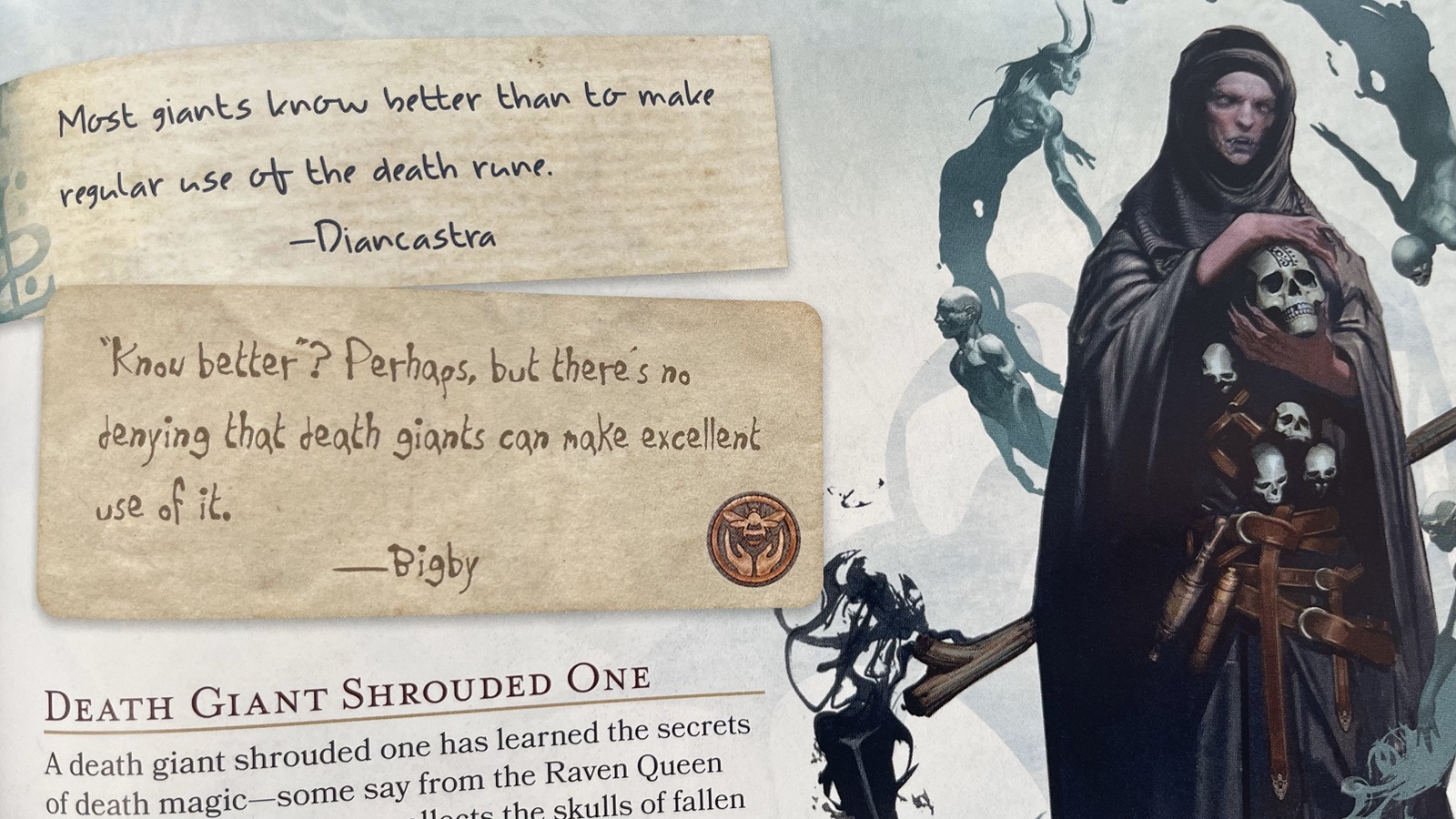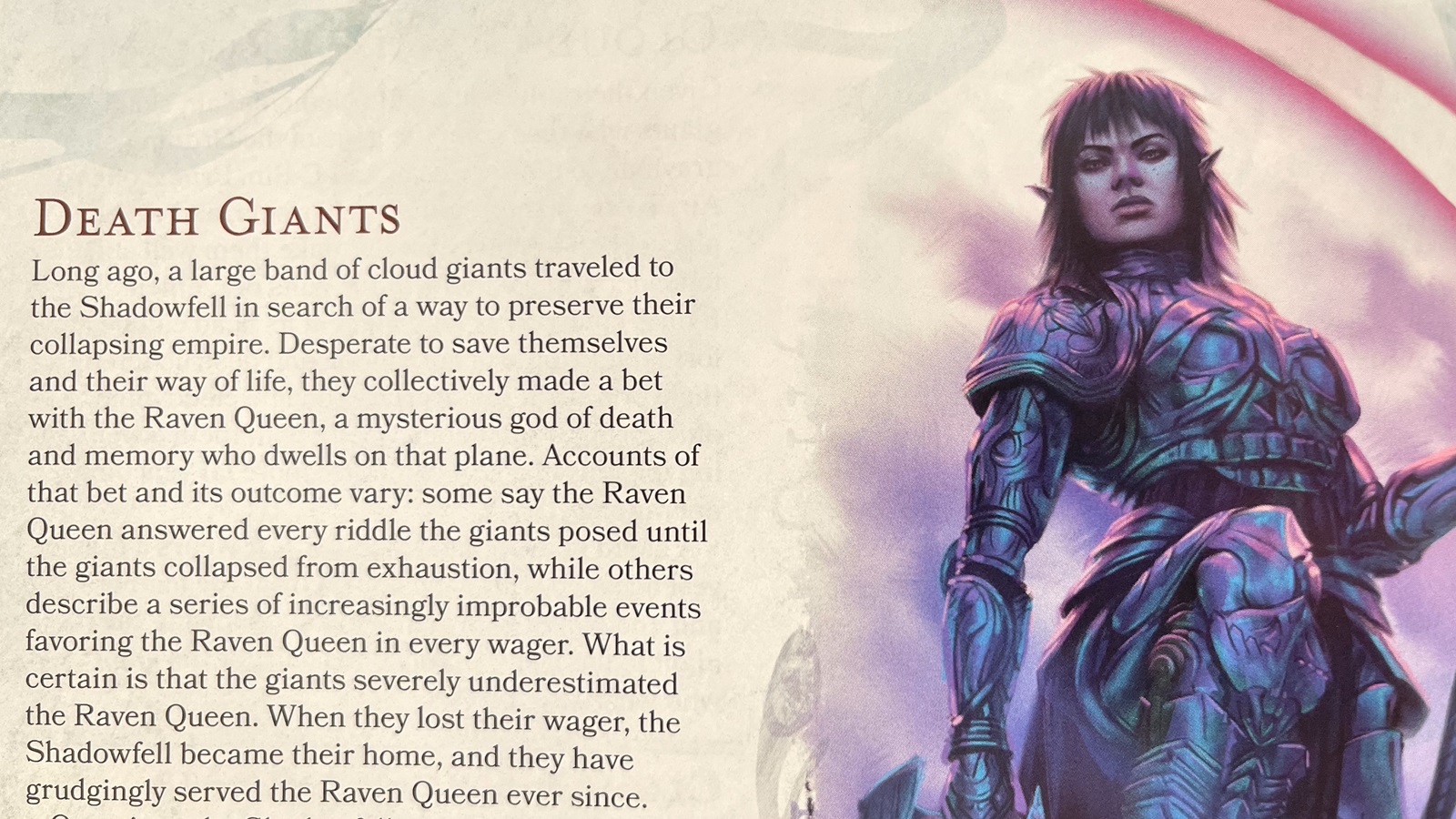
In D&D lore giants share the stage with dragons as the first races to rise to prominence. The giant races are credited with having been around almost as long as the dragons and having fought wars lasting generations against the dragons for dominance over the world. While dragons have seen their own dedicated publications in several editions of D&D, giants haven’t been as fortunate. With the publication of Bigby Presents Glory of the Giants, Wizards of the Coast rectifies that oversight, giving us a book that is dedicated cover to cover to the giants of the D&D multiverse. One of about a dozen expansion books for the D&D 5th Edition rules, Bigby’s Glory of the Giants digs into the myths, history, society, and gods of the D&D giant races. This is not, in fact, Wizards of the Coast’s first 5th edition book that digs into the giants – previous publication Volo’s Guide to Monsters has a section dedicated to them. But Volo only dedicated about fifteen pages to giants, Bigby gives us, in contrast, about 190.
Like many 5th edition books, this one comes in two covers, both with beautiful artwork. The book is broken down into six chapters that help Dungeon Masters incorporate giants into their worlds, campaigns, and adventures. The first chapter offers a few new options for players to add to their characters. The second chapter provides DMs with details about giants to bring them to life in their worlds. The third chapter focuses on building encounters, adventures, and campaigns around giants. The fourth chapter provides giant-based locations for DMs to build out. Chapter five digs into what’s in giant treasures. The last chapter is a bestiary. Two very brief appendices round out the book with some inspiring concept art and an index of adventure hooks that are found throughout the book.

A comparison of the two cover versions.
Like similar guides in the D&D 5th Edition library, Bigby provides commentary throughout the book in flavor text boxes. He shares this space with a giantess god named Diancastra. The two of them pepper the book with their comments, usually in reference to the text, sometimes in reference to each other. I cannot say that the comments are always useful, but like the other books using the same style, it gives the books a bit of a scholarly feel and is less like a pure rules reference. Before the book dives straight into the chapters, a brief introduction sets up some expectations for the book and provides a few short paragraphs about the giants of the Forgotten Realms, Greyhawk, Dragonlance, and Eberron. The book is largely focused on the humanoid creatures of the game with “giant” in their name; that is: hill giants; fire giants; frost giants; stone giants; cloud giants; storm giants; and death giants (introduced in this book). But it’s not exclusively focused on those giants – including information concerning some giant-related creatures: fomorians; trolls; and cyclopes. I was happy to see the addition of giant-kin in the book, especially with some additional backstory for the fomorians. Not all giant-kin receive the same level of treatment, but there’s enough in here to get a DM started with a few fomorian adventures. But be forewarned, if you are not planning on a lot of giant activity in your campaign, the pickings are slim for alternate content.
The first chapter briefly delves into some content directly relevant to players and of use to their characters. There is a new sub-class option for barbarians called the Path of the Giant. This sub-class lends strength and size as features along the path, for instance, the 14th-level Demiurgic Colossus feature increases the size of the barbarian to Large or Huge and increases their reach to ten feet. There are two backgrounds available to players related to giants, the Giant Foundling is a character that grew up among giants and the Rune Carver is someone who studies giant runes.The two backgrounds create a balance issue, each coming with a powerful ability, so to balance it out, if a DM allows these backgrounds in their game, they are advised to give everyone else a bonus feat to keep them on par with player characters that take these backgrounds. It’s an interesting solution to the problem, but I wonder if fixing an overpowered feature by powering everything else up is the appropriate way to go. I can see it making encounter building, especially at lower levels, more difficult. A brief section provides storytelling flavor related to giants that can be incorporated into a character’s background such as having come from giant regions, having giant ancestors, and other options. And finally, the chapter includes eight new giant-related feats. This tiny chapter has a few gems in it, for instance, a stand-out is the Rune Shaper feat, which gives the player character access to an additional spell throughout the day by carving it onto an object that they then carry with them. Casting the spell takes a spell slot, but it does add to the potential spells that a character can draw on, increasing their versatility.

Bigby and Diancastra provide a running commentary.
The second chapter deals with how giants are part of the world. First, the chapter covers the root ideas that DMs should keep in mind when roleplaying giants, focusing on the things that make giants different. The Ordnung (the giants’ class system) is discussed in detail, then the myths around the creation of the giants by their creator god, Annam. All the various giant races are attributed to various gods who are the children of Annam. Each of Annam’s children is described and their relationships with the giant races are outlined. There are brief paragraphs dealing with priests and religious practices for each of the giant gods as well. There is a discussion of various giant social structures, and the chapter concludes with descriptions of three giant organizations. Roleplaying tips for DMs can help maintain the flavor and immersion for the players and liven up an otherwise bland encounter. The section looking at how the Ordnung impacts giant thinking and actions might be digging a little deep for many DMs, but the adventure hooks associated with each giant type will also help maintain the immersion. The giant organizations seem particularly helpful from a campaign construction perspective – these organizations can act as patrons for player characters or as opponents. I’m all for organizations that DMs can drop into their worlds, especially those that can benefit players. Being approached by the Worldroot Circle for help instead of the Harpers would make for an interesting change of pace in many campaigns.
Giant encounters, adventures, and campaigns are the focus of the third chapter. Encounters are broken down into tables by giant type. A die roll in a table will produce a random encounter that a DM can drop into their game. This chapter has a helpful boxed out section that lays out the types of giants that are appropriate for various levels of play. It functions as a handy planning reference for DMs trying to give their players a challenge that won’t lead to the entire party rolling up new characters. Sections on elemental and fiendish encounters provide random encounters for areas that are heavily influenced by elemental and fiendish planes, perhaps in an area surrounding a planar gate, or where a rift is leaking into the game setting. There are also some tables for constructs, giant-kin, giant necropolises, and megafauna. The section on adventures outlines five types of adventures that help a DM decide how to incorporate giants into a campaign. This chapter is chock full of ideas, from the encounter tables, adventure hooks to ideas on campaigns, a savvy DM can mine this chapter for multiple campaigns.

The fourth chapter contains eighteen giant–related enclaves. They are each two pages long: one page has a map, and the other page has an overview of the area. Each enclave includes a few special characteristics and a handful of adventure hooks. Most of the locations are a few hundred feet across and deal with one building or area, but they aren’t all that small, one is of a region 80 miles across that has multiple villages. Each of the enclaves serves multiple purposes, so a DM can pick and choose exactly how the locations serve best in their world. These could be adventure sites that springboard the beginning of a series of adventures, or they could be the set pieces at the end of an adventure. There are plenty of ideas in the descriptive text that accompanies each of the locations, or a DM might just choose to use the map and develop the location as they see fit. The adventure hooks and features described are good enough for DMs to jump right in and go. As an example, the Forest Crystal location can be dropped into almost any forest in any DM’s setting. It has a huge crystal in the middle that produces a magic shroud and creates a Wild Magic effect. The Forest Crystal section includes four accompanying adventure hooks that can be side quests or springboards into a series of adventures, or even a campaign – all based on this one location. Most DMs should be able to find something useful here, even if it’s just the maps.
Chapter five, Giant Treasures, dives into giant relics, giant-related magic items, and the contents of giants’ bags. Obviously, the section on giants’ bags details what might be found in the bags of various giants. It’s a nice detail to give a DM’s various giants additional flavor. There is enough variation here that a character with some knowledge of giants could potentially identify what kind of giant owns a bag without seeing the giant. Adding the additional flavor of the contents of giant bags adds a heaping of flavor into an otherwise mundane, and possibly overlooked, part of the giant lore. The section on giant relics is just a page and a half describing what kind of mundane treasures might be found in a giant setting. It might be interesting for those DM’s looking to keep leaning into the giant ascetic throughout gameplay, but it’s maybe not that useful of a section. The chapter closes out with a discussion of giant-sized magic items and details a couple-dozen magic items that relate to giants and giant-kind in some way.

Death giants are impressive.
The last and longest chapter (almost half of the book) is a bestiary of giants and giant-related creatures. There are new giant dinosaurs standing hundreds of feet tall. There is an ettin mindflayer. There are new types of specific giants, like the frost giant ice shaper. Giant versions of normal animals, including a giant ox, which come in many colors (including blue for the Paul Bunyan fans). And there’s a giant goose in case your game needs some giant golden eggs, and to help with that, there’s a table for what might be inside the golden egg. There’s a good spread of challenge ratings topping out with the CR 27 Scion of Stronmaus, one of several super-powerful grandchildren of the god Annam. There are some truly inspiring creatures in this bestiary.
Bigby Presents Glory of the Giants
Great
Glory of the Giants is a deep dive into just a part of the D&D multiverse and it produces a trove of information. From dozens of adventure hooks to tons of new monsters, this book is packed with content, but its biggest selling point is inspiration. With an eye towards giant culture, giant history, and giant thinking, DMs are likely to have dozens of ideas of their own before they draw on the adventure and campaign ideas in the book. Any DM can find useful information here for one of the off-the-shelf campaign settings or their own homebrew. This book will bring giants into the center of a campaign world instead of keeping them lurking on the fringes. If a DM is not interested in the giant content the remaining less giant-oriented content might not be worth buying the whole book. Players, on the other hand, will probably best benefit from this book as a loan from their DM considering the slim content available to them. All in all, a DM can't go wrong with this book, provided they are interested in adding a giant dose of giants to their campaign.
Pros
- Dozens of adventure hooks
- Expansive bestiary
- Inspirational throughout
Cons
- Focus on giants limits usefulness
- Not much content for players
